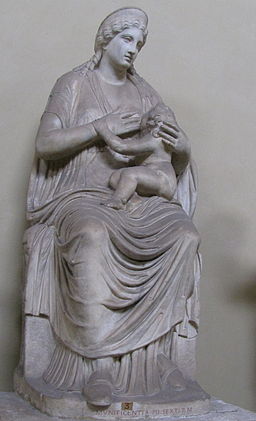The Story
Christmas is a day for Christians to celebrate the birth of Jesus. The twelve days of Christmas are a period of celebration, linking the Christmas dates on the Roman and Orthodox calendars.
Christmas presents recreate the birthday gifts given by the Magi to Jesus. This tradition follows the example of Saint Nicholas.
Gathering together to celebrate makes families stronger. Yule logs and dinners of Christmas ham provide something to gather around. Christmas cards allow one to spread the joy to others that can't be here. Caroling brings happiness to others.
Decorations also provide happiness. Ivy's leaves are shaped like Jesus's heart. Holly symbolizes Jesus's crown of thorns, the red berries representing his shed blood. Evergreens, which stay green even in winter, symbolize eternal life. These trees form an arrow pointing to heaven, and their triangular shape represents the trinity.
Historical Facts
Egyptian

Isis nursing Horus.
Horus, the ancient Egyptian sun god, was celebrated at the winter solstice. At these celebrations he was often depicted as an infant being fed by his mother Isis. Ancient statues and paintings of this mother and child are remarkably similar to the maddonas still used by the Roman Church to represent Mary and Jesus.
Roman
Long before Jesus's time, the Romans had been celebrating in late December.
Saturnalia was a festival from the 17th to the 23rd of December in honour of the god Saturn. It involved continual partying and gift-giving.
Dies Natalis Solis Invicti, the Birthday of the Unconquered Sun, was celebrated on December 25, which was believed to be the winter solstice.
Wreaths of evergreen were used to decorate houses during these festivities.
Nordic and Germanic
Wreaths of evergreen were also popular in the celebrations of the Germanic and Nordic people, who worshiped trees as gods. They also decorated with holly, ivy, and mistletoe.
Yule logs were burned for twelve days, perhaps in memory of the human sacrifices performed by their ancestors.
The Yule Boar, roasted whole with an apple in its mouth, was eaten in honour of the god Freyr, and is represented today as Christmas ham.
Slavic
Koliada was an ancient winter festival celebrating death and rebirth. Groups of people would wander from house to house, greeting the inhabitants with songs.
Catholic
Saint Nicholas was a 4th century Roman Bishop, famous for his generosity and anonymous gift giving.
Over the centuries his name became corrupted to what is now the English name Santa Claus
.
Protestant
Following the Protestant Reformation, many non-Roman churches unsuccessfully tried to remove the pagan influences associated with Christmas. The celebration of Christmas was banned in England from 1647 to 1660. It was outlawed for even longer in Scotland, from 1637 to 1690, where it didn't become a public holiday until 1958.
In the new world, the Plymouth Pilgrims banned celebrations of Christmas, and deliberately worked on that day to emphasize their position. Christmas was outlawed in Boston Massachusetts from 1659 to 1681, and remained socially unacceptable for another 200 years.
Much of today's celebrations were introduced to North America by Pennsylvania German settlers, who brought enthusiastic celebrations, Christmas trees, Yule logs, and other Germanic traditions.
Secular
Office parties, street decorations, parades, lavish gifts, etc. are all recent innovations.
Even the practice of sending Christmas cards dates back less than two hundred years, following the development of regular postal delivery systems.
The Bible
The Bible nowhere suggests celebrating Christmas or anything like it. It nowhere says when Jesus was born, and what information it does provide indicates that it was not anywhere near December 25.
The Bible predicted that Christians would ignore God's commandments and instead use pagan practices in their worship:
- Adopting pagan practices, sincerely believing they can be used to honour God and Jesus:
Take heed to thyself that thou be not snared by following them, ... and that thou enquire not after their gods, saying, How did these nations serve their gods? even so will I do likewise. Thou shalt not do so unto the LORD thy God ... . What thing soever I command you, observe to do it: thou shalt not add thereto, nor diminish from it.
-- Deuteronomy 12:30-32 - Appearing to worship God, but following man's ways of doing so rather than God's:
This people draweth nigh unto me with their mouth, and honoureth me with their lips; but their heart is far from me. But in vain they do worship me, teaching for doctrines the commandments of men.
-- Matthew 15:8-9 - Sincerely but mistakenly believing they were doing what God wanted:
Wherefore by their fruits ye shall know them. Not every one that saith unto me, Lord, Lord, shall enter into the kingdom of heaven; but he that doeth the will of my Father which is in heaven. Many will say to me in that day, Lord, Lord, have we not prophesied in thy name? and in thy name have cast out devils? and in thy name done many wonderful works? And then will I profess unto them, I never knew you: depart from me, ye that work iniquity.
-- Matthew 7:20-23
Why
Almost everything associated with Christmas is of direct pagan origin. Even the parts that seem to deal directly with Jesus are mostly false and not in accord with the Bible.
Roman Catholicism grew by incorporating the myths of other religions and then renaming the characters or events to sound Christian. Despite their claims otherwise, most Protestant churches eventually accepted many of these pagan myths and traditions as part of their own practice.
And of course the advertising industry loves Christmas. Everyone spends copiously, even though for most people it means being in debt a week later in the new year.